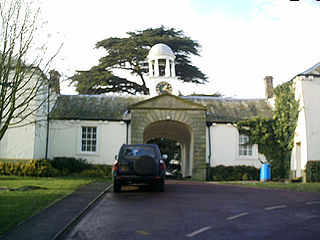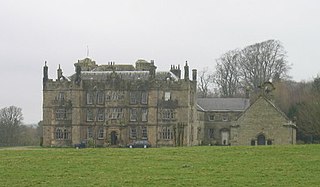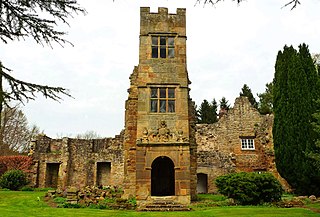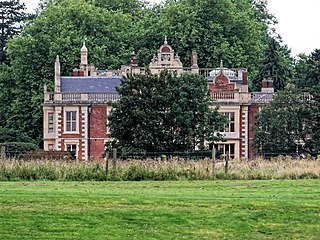
Meldon Park is a privately owned country mansion situated at Meldon, Northumberland. It is a Grade II* listed building. [1]

Meldon Park is a privately owned country mansion situated at Meldon, Northumberland. It is a Grade II* listed building. [1]
In 1832, Isaac Cookson commissioned architect John Dobson to replace the old manor, which stood on the banks of the River Wansbeck, with a new mansion, which was completed in 1835. [1] During the 20th century, extensive internal improvements and embellishments were carried out by Edwin Lutyens. [1]
The Manor of Meldon was anciently held by the Fenwick family from whom it passed by marriage to the Radclyffes. [2] James Radclyffe, 3rd Earl of Derwentwater lost the estate to the Crown following his attainder for treason in the 1715 Jacobite rising. [2] The house was put on the market for sale in 2022. [3]
The Crown granted the estate to the Greenwich Hospital, by whom it was sold in 1832 for £55,000 to Isaac Cookson, a wealthy Newcastle upon Tyne merchant. [2] Cookson was Mayor of Newcastle in 1809 and High Sheriff of Northumberland in 1838. In 1881, the Cookson family lived in some style with eighteen servants. [4] The house and grounds were sold in Dec 2022. Meldon Park offers holiday accommodation (known as Meldon Cottage) which is available to book. [5]
The Cookson Family Papers are archived at Durham University Library Archives. [6]

Bedlington is a town and former civil parish in Northumberland, England, with a population of 18,470 measured at the 2011 Census.

Ellington is a small village in the civil parish of Ellington and Linton, on the coast of Northumberland, England. Ellington is 4 miles (6 km) from Ashington, 6 miles (10 km) from Morpeth and 20 miles (32 km) north of Newcastle upon Tyne.

Newminster Abbey was a Cistercian abbey in Northumberland in the north of England. The site is protected by Grade II listed building and Scheduled Ancient Monument status.
This is a list of the high sheriffs of the English county of Northumberland. The high sheriff is the oldest secular office under the Crown. Formerly the High Sheriff was the principal law enforcement officer in the county but over the centuries most of the responsibilities associated with the post have been transferred elsewhere or are now defunct, so that its functions are now largely ceremonial. The High Sheriff changes every March.
Mitford is a village in Northumberland, England, located two miles west of Morpeth.

Ogle is a village in and former civil parish, now in the parish of Whalton, Northumberland, England, north-west of Ponteland and south-west of Morpeth. The surname Ogle comes from here, where the Ogle family built Ogle Castle and owned Kirkley Hall. In 1951 the parish had a population of 122.

Chipchase Castle is a 17th-century Jacobean mansion incorporating a substantial 14th-century pele tower, which stands north of Hadrian's Wall, near Wark on Tyne, between Bellingham and Hexham in Northumberland, England. It is a Scheduled Ancient Monument and a Grade I listed building.

Mitford Old Manor House is an historic English manor house at Mitford, Northumberland, and is a Grade II* listed building. The Manor of Mitford was held from ancient times by the Mitford family.

Worksop Manor is a Grade I listed 18th-century country house in Bassetlaw, Nottinghamshire. It stands in one of the four contiguous estates in the Dukeries area of Nottinghamshire. Traditionally, the Lord of the Manor of Worksop may assist a British monarch at his or her coronation by providing a glove and putting it on the monarch's right hand and supporting his or her right arm. Worksop Manor was the seat of the ancient Lords of Worksop.

Nunnykirk Hall is a 19th-century country house and Grade I listed building in the civil parish of Nunnykirk, near the village of Netherwitton in the English county of Northumberland. The hall is now a school.

Lilburn Tower is a privately owned 19th-century mansion house at Lilburn, near Wooler, Northumberland. The property is a Grade II* listed building and forms part of the Lilburn Estate. A number of discrete buildings and monuments are scattered across the grange, including the Hurlestone, Hurlestone Tower and an astronomical observatory.
John Green and Benjamin Green were a father and son who worked in partnership as architects in North East England during the early nineteenth century. John, the father was a civil engineer as well as an architect. Although they did carry out some commissions separately, they were given joint credit for many of their projects, and it is difficult to attribute much of their work to a single individual. In general, John Green worked on civil engineering projects, such as road and rail bridges, whereas Benjamin worked on projects that were more purely architectural. Their work was predominantly church and railway architecture, with a sprinkling of public buildings that includes their masterpiece, Newcastle's Theatre Royal.

Rock Hall is a privately owned 18th-century country house, at Rock, Rennington, near Alnwick, Northumberland. It is a Grade II* listed building.

Swarland Old Hall is a small 17th-century country house at Swarland, Northumberland, England. It is a Grade II* listed building.

Matfen Hall is a 19th-century country mansion in Matfen, Northumberland, England, the seat of the Blackett baronets and now also a hotel and country golf club. It is a Grade II* listed building.

Bellingham Castle was a motte and bailey fortress in Northumberland, founded by the De Bellingham family. Its remains lie 5 miles east of Dally Castle, near the village of Bellingham. There is no evidence to suggest that any fortification existed on the site before 1157, when the lands were granted as liberty to the King of Scotland. According to sources, a castle and manor house was erected on a mound now known as Hallsfield during the reign of Richard II by a certain Richard De Bellingham of the De Bellingham Family, who were given the estate as well as the title of Baron by the monarch. The estate was then passed on to the Derwentwater family. However due to his joining the rebel cause during the Jacobite Rising of 1715, James Radclyffe, 3rd Earl of Derwentwater was stripped of his title and his estate and after his attainder and execution, the manor was awarded to the Governors of the Greenwich Hospital. By the 13th century all traces of the castle proper and its fortifications had been lost.

Dilston Castle is an unglazed 15th-century uninhabited tower house at Dilston in the parish of Corbridge, Northumberland, England. Both are scheduled monuments and Grade I listed buildings giving them recognition for historic and architectural value as well protection from demolition.

Baynards Park is a 2,000 acres (810 ha) estate and site of a demolished country house with extant outbuildings, privately owned, in the south of the parishes of Cranleigh and Ewhurst, Surrey.

Barrington Hall is a Grade II* listed 18th-century English country house in Hatfield Broad Oak, Essex, England.

Morpeth Court is a former judicial structure on Castle Bank, Morpeth, Northumberland, England. The structure, which used to be the entrance block for a prison as well as the main courthouse for the area, is a Grade II* listed building.
![]() Media related to Meldon Park, Hartburn at Wikimedia Commons
Media related to Meldon Park, Hartburn at Wikimedia Commons